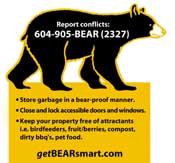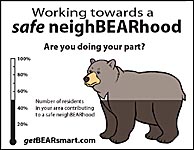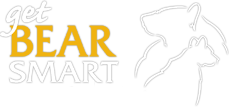An innovative tool to effectively foster sustainable bear smart behaviour
Numerous studies document that education alone does not alter behaviour. Conventional marketing, which often relies heavily on media advertising, can be effective in creating public awareness and understanding of issues, but is limited in its ability to foster behaviour change.
Campaigns that rely solely on providing information
often have little or no effect upon behaviour.
Community-based social marketing is based upon research in the social sciences that demonstrates that behaviour change is most effectively achieved through initiatives delivered at the community level which focus on removing barriers to an activity while simultaneously enhancing the activities benefits. To be effective, programs must be carried out at the community level and involve direct contact with people.
Community-based social marketing involves four steps:
- Identifying the barriers and benefits to an activity,
- Developing a strategy that utilizes “tools” that have been shown to be effective in changing behaviour,
- Piloting the strategy, and
- Evaluating the strategy once it has been implemented across a community.
This section is designed to introduce you to community-based social marketing tools that will foster sustainable bear smart behaviour. The information has been summarized from the work of Doug McKenzie-Mohr, Ph.D., Environmental Psychologist, and is intended only to provide a brief introduction. We recommend that you refer to resources below for more detailed information.
Why do some people adopt bear smart practices, while others do not?
- people may not know about bear smart practices
- people may perceive significant barriers associated with becoming bear smart
- it may simply be easier to carry on as they are
To influence what people do, we must understand what they perceive as the barriers and benefits of becoming bear smart.
- people will naturally gravitate to actions that have high benefits and for which there are few barriers
- perceived barriers and benefits vary dramatically among individuals – a benefit to one person, may be a barrier to another
- people need to make choices and prioritize actions each day – adopting one behaviour means rejecting another
Uncovering barriers and benefits
- research and review relevant articles and reports
- obtain qualitative information through focus groups and observation to explore in-depth bear smart attitudes and behaviour of residents
- conduct a survey with a random sample of residents
Tools of Behaviour Change
Commitment
Generally, people who have initially agreed to a small request, such as to sign a “Promise to the Bears“, have subsequently been found to be far more likely to agree to a larger request, such as actually purchasing a bear-proof waste container. Whenever possible, ask permission to make a commitment public e.g. publish the names of residents who promised to be bear smart in the local newspaper. Group commitments can also be effective, like asking the local Rotary or Lion’s Club membership to commit to becoming bear smart. Or, asking a community “block leader” who already employs bear smart practices to speak to their neighbours and get them started.
 Prompts
Prompts
Many bear smart practices are susceptible to the most human of traits: forgetting e.g. people have to remember to close the lid on the bear-proof container. Prompts can be very effective in reminding us to perform these activities. A sign can be placed on the bear-proof container to close the lid. The sign must be visually interesting and well-placed. Fridge magnets, book marks or door hangers can also be used to prompt bear smart behaviours.
Norms
Social norms guide how we should behave. If we observe others acting in a bear smart manner, such as deterring a bear from their property, we are more likely to act similarly by emphasizing that it is simply “not acceptable” to attract bears to your property and create a safety risk for your neighbours. Just like it has become socially unacceptable to drive drunk or litter, we need to work toward making it socially unacceptable to be bear un-aware.
Communication
- Use captivating information by ensuring it is vivid, personal and concrete e.g. if a bear gains access to one birdfeeder, the caloric and nutritional content is equivalent to foraging on clover and dandelions for several days.
- Know your audience by having a firm sense of their attitudes, beliefs and behaviour e.g. at what point do residents lose their tolerance for bears in the community, when they destroy personal property or not until they enter their personal residence. This is accomplished through focus groups and surveys.
- Use a credible source that is seen to have expertise and be trustworthy e.g. biologists and bear aware educators.
- Frame your message by emphasizing what the individual is losing by not acting e.g. stress the threat to human safety, property damage, destruction of bears as the result of inaction.
- Carefully consider threatening messages e.g. repeatedly presenting a threatening message like “A fed bear is a dead bear” can cause people to become habituated to the message. Once people understand the “crisis”, it is wise to move primarily or exclusively on to dealing with the solution.
- Make your message (especially instructions) easy to remember, clear and specific e.g. When you encounter a bear: Stay Calm, Stand Still, Speak Softly and Slowly Backup.
- Provide goals or targets for the community to meet, as a whole or as individuals e.g. install a sign at the entrance to each sub-division that is an ongoing tally of the number of bear smart residences.
- Emphasize personal contact by creating opportunities for people to talk to one another e.g. presentations, home visits.
- Model the bear smart behaviours you want people to engage in e.g. show a person disposing of garbage in a bear-proof container, removing their birdfeeder or picking up fallen fruit from below the tree – this can be accomplished through TV (community programming channel), video or PowerPoint presentation. You could also put on a live demonstration showing how to deter a bear from your backyard or set-up a passive deterrent like the Scarecrow.
 Make sure that your program enhances social diffusion by increasing the likelihood that people will discuss their new activity with others e.g. publish the names of people in the paper who have initiated a bear smart practice at home, providing an opportunity for those who recognize someone’s name to approach that person and ask about it.
Make sure that your program enhances social diffusion by increasing the likelihood that people will discuss their new activity with others e.g. publish the names of people in the paper who have initiated a bear smart practice at home, providing an opportunity for those who recognize someone’s name to approach that person and ask about it.- Provide feedback about the effectiveness of both an individual resident’s actions as well as the community as a whole. This will impact the adoption and maintenance of the new behaviours.
Incentives
Incentives whether financial or other wise (e.g., social approval), can provide the motivation for individuals to perform more effectively an activity they already engage in, or to begin an activity that they otherwise would not perform e.g. rebates on purchase of bear-proof containers, a competition between neighBEARhoods for the most bear smart residences, public recognition of an individual or organization’s activities like publishing the Bear Smart Business of the Week in the local paper.
Removing External Barriers
Many of the behaviour change strategies presented above can have a significant influence upon the adoption and maintenance of behaviour. However, they will be ineffectual if significant external barriers exist to the behaviour you wish to promote. Bear smart practices must be convenient and inexpensive to implement. It is important to identify barriers and plan for how you will overcome them. The first step is identifying barriers through a literature search, focus groups or phone survey.
Evaluation
Evaluate the community-wide implementation by obtaining information on baseline involvement in the activity prior to implementation, and at several points afterward.
NOTE: This section is designed to introduce you to community-based social marketing tools that will foster sustainable bear smart behaviour. The information has been summarized from the work of Doug McKenzie-Mohr, Ph.D., Environmental Psychologist, and is intended only to provide a brief introduction. We recommend that you refer to resources below for more detailed information.
Fostering Sustainable Behavior: An Introduction to Community-Based Social Marketing (Third Edition)
Read the book online.
